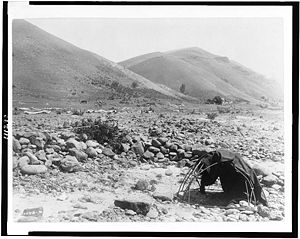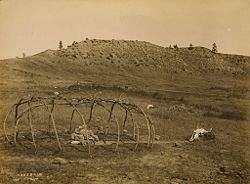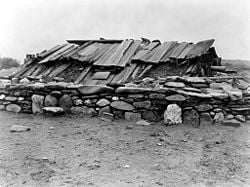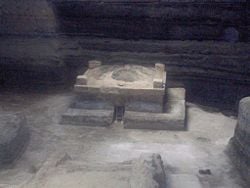Sweat lodge

The sweat lodge (also called purification ceremony, sweat house, medicine lodge, medicine house, or simply sweat) is a ceremonial sauna and is considered an important tradition in some Native American cultures. Sweats are often done for purification, both physical and spiritual. It may be a deeply spiritual experience. Others participate for social and cultural reasons.
There are risks involved in the use of sweat lodges, especially when run by unauthorized and untrained persons. When organized with due respect to the process in both its physical and cultural aspects, sweat lodges offer valuable experiences for many.
Description
Sweat lodges can be constructed in a variety of styles. They may be fashioned as a domed or oblong hut similar to a wickiup (or wigwam), of a size large enough to accommodate several people. Even a simple hole dug into the ground and covered with planks or tree trunks may be used. Stones are typically heated in an exterior fire before being placed in a central pit in the ground.[1] The stones are then sprinkled with water to generate steam.
Sweat lodges have been used for three main purposes[2]
- religious - often for purposes of purification or preparation for an event such as war
- therapeutic - in which evil spirits causing the disease were to be removed usually under the supervision of a shaman
- social or hygienic - when the sweat lodge as a functioned as a communal bath house
Native American Sweat Lodges
Indigenous peoples of the Americas in many regions have employed the sweat lodge. This tradition goes back many hundreds of years. For example, Chumash peoples of the central coast of California built sweat lodges in coastal areas in association with habitation sites dated back to between 800 to 1200 C.E.[3] Many tribes continue to use the sweat lodge today.

Rituals and traditions vary from region to region and from tribe to tribe. They often include prayers, drumming, and offerings to the spirit world. In some cultures a sweat-lodge ceremony may be a part of another, longer ceremony such as a Sun Dance. Some common practices and key elements associated with sweat lodges include:
- Construction – The lodge is generally built with great care and with respect to the environment and to the materials being used. A common form of sweat lodge is constructed by placing saplings in the ground and then bending them over and attaching them together.[4] Many traditions construct the lodge in complete silence, some have a drum playing while they build, other traditions have the builders fast during construction.
- Symbolism – The saplings are grounded in the earth representing the role Mother Earth plays in healing, purification, and obtaining spiritual experiences. The cardinal directions usually have distinct symbolism in Native American cultures and thus the location of each sapling represents a different aspect of life and the ceremony.[4]
- Offerings – Various types of plant medicines are often used to make prayers, give thanks or make other offerings. Prayer ties are sometimes made.
- Darkness - Many traditions consider it important that sweats be done in complete darkness.
- Clothing – In Native American lodges participants usually wear a simple garment such as shorts or loose dresses.
- Support – In many traditions, one or more persons will remain outside the sweat lodge to protect the ceremony, and assist the participants. Sometimes they will tend the fire and place the hot stones, though usually this is done by a designated firekeeper. In another instance, a person that sits in the lodge, next to the door, is charged with protecting the ceremony, and maintaining lodge etiquette.
The most important part of sweat lodge etiquette is respecting the traditions of the lodge leader. It is important to know what is allowed and expected before entering a lodge. Traditional tribes hold a high value of respect to the lodge. Some sweats take place in complete silence, while others involve singing, chanting, drumming, or other sounds. In some cultures objects, including clothing, without a ceremonial significance are discouraged from being brought into the lodge. Most traditional tribes place a high value on modesty as a respect to the lodge. In clothed lodges, women are usually expected to wear skirts or short-sleeved dresses of a longer length. In some traditions, nudity is forbidden, as are mixed gender sweats, whereas in others nudity is considered to have a greater connection with the spiritual aspect of the sweat. Some lodge leaders do not allow menstruating women. Perhaps the most important piece of etiquette is gratitude. It is important to be thankful to the purpose of the sweat, the other participants, and those helping to support the sweat lodge.
Inipi (Lakota Sweat Lodge)
The I-ni-pi ceremony, a type of sweat lodge, is a Lakota purification ceremony, and one of the Seven Sacred Rites of the Lakota people.[5] It is an ancient and sacred ceremony of the Lakota people and has been passed down through the generations of Lakota.
The full ceremony is not taught to non-Lakotas, but in rough detail it involves an I-ni-pi lodge - a frame of saplings covered with hides or blankets. Stones are heated in a fire, then placed into a central pit in the lodge. Water is then poured on the stones to create hot steam. Traditional prayers and songs are offered in the Lakota language.
Those who have inherited and maintained these traditions have issued statements about the standards to be observed in the I-ni-pi.[5][6]
At the Lakota Summit V on June 10, 1993, an international gathering of US and Canadian Lakota, Dakota, and Nakota Nations, about 500 representatives from 40 different tribes and bands of the Lakota unanimously passed a "Declaration of War Against Exploiters of Lakota Spirituality." Among other things, it specifies that these ceremonies are only for those of the Lakota, Dakota, and Nakota Nations.[6]
In a March 2003 meeting of the spiritual leaders and Bundle Keepers of the Lakota, Dakota, Nakota, Cheyenne, and Arapahoe Nations it was agreed that:
I-ni-pi (Purification Ceremony): Those that run this sacred rite should be able to communicate with Tun-ca-s'i-la (our Sacred Grandfathers) in their Native Plains tongue. They should also have earned this rite by completing Han-ble-c'i-ya and the four days and four years of the Wi-wanyang wa-c'i-pi.[5]
Temazcal
A temazcal (also written as temezcal, temascal, or temescal) is a type of sweat lodge which originated with pre-Hispanic Indigenous peoples in Mesoamerica. The word temazcal comes from the Nahuatl (Aztec) word temazcalli which comes from two words, temas which means bath (or teme to bathe), and calli meaning house.[7][8] The Mayans called these sweat baths Zumpul-che, meaning "a bath for women after childbirth and for sick persons used to cast out disease in their bodies."[8]
The temazcal sweatlodge in Mesoamerica is usually a permanent structure, unlike in other regions. Constructed from volcanic rock and cement it is usually a circular dome, although rectangular ones have been found at certain archeological sites. To produce the heat, volcanic stones, which do not explode from the high temperature, are heated and then placed in a pit located in the center or near a wall of the temazcal.
In ancient Mesoamerica the temazcal was used as part of a curative ceremony thought to purify the body after exertion such as after a battle or a ceremonial ball game. It was also used for healing the sick, improving health, and for women to give birth. It continues to be used today for spiritual and health reasons in Indigenous cultures of Mexico and Central America that were part of the ancient Mesoamerican region.
The temazcal involved the worship of a goddess, Temazcalteci, "the grandmother of the baths," and incorporated all the elements of Aztec mythology. The Spanish colonialists, horrified at the idea of people of both genders bathing naked together and participating in what they assumed to be immoral acts, determined to eradicate this practice that was so closely connected to pagan beliefs. Despite their best efforts, however, the temazcal survived, practiced secretly in remote locations.[7] It is currently being recovered by all sectors of society in that part of the world and is used as a cleansing of mind, body, and spirit.
Sweat Lodges in Other Cultures
Sweat lodges have been used in the northern cultures not only of the Americas but also Europe.[2] One of the early European occurrences can be found in the fifth century B.C.E., when Scythians constructed pole and woolen cloth sweat baths for purification purposes, particularly following a death.[9] Vapor baths are also documented in Roman times by Vitruvius.
In Ireland a beehive shaped sweat lodge was commonly used through the eighteenth and even nineteenth centuries, especially as a cure for rheumatism.[2] In Northern European cultures, such as in Finland where they are known as saunas, sweat lodges were and are common and have ceremonial and therapeutic aspects. In Russia, too, ceremonial sweat baths were commonly used by the peasants for purification.[2]
The "Turkish bath," similar to a sauna or Russian sweat bath but related to ancient Greek and ancient Roman bathing practices, was introduced into Great Britain by David Urquhart, a diplomat and politician, and Richard Barter, an Irish physician, who read Urquhart's The Pillars of Hercules and worked with him to construct the first such bath in the mid-nineteenth century.
Risks
Participating in a sweat carries risks, especially to those who have medical problems such as heart problems, seizure disorders, especially combined with drug or alcohol use, can lead to problems such as hyperthermia, when the body produces or absorbs more heat than it can dissipate.[10]
Wearing metal jewelry can be dangerous since metal objects may become hot enough to burn the wearer. Contact lenses and synthetic clothing should not be worn in sweat lodges as the heat can cause the materials to melt and adhere to eyes or skin.[11]
Care must be taken in selecting rocks used for heating. They should be dry and without air pockets, as these will crack and possibly explode in the fire or when hit by water. There is also a risk posed by modern chemical pesticides, or inappropriate woods, herbs, or building materials being used in the lodge.
Even people who are experienced with sweats, and attending a ceremony led by a properly-trained and authorized Native American ceremonial leader, could suddenly experience problems due to underlying health issues.
There have been reports of sweat lodge-related deaths resulting from overexposure to heat, dehydration, smoke inhalation, or improper lodge construction leading to suffocation.[12][13] In October 2009, during a New Age retreat organized by James Arthur Ray, three people died and 21 more were sickened from an overcrowded and improperly set up sweat lodge containing some 60 people and located near Sedona, Arizona.[14]
In response to these deaths, Lakota spiritual leader Arvol Looking Horse issued a statement reading in part:
As Keeper of our Sacred White Buffalo Calf Pipe Bundle, I am concerned for the 2 deaths and illnesses of the many people that participated in a sweat lodge in Sedona, Arizona that brought our sacred rite under fire in the news. I would like to clarify that this lodge and many others, are not our ceremonial way of life, because of the way they are being conducted. My prayers go out for their families and loved ones for their loss.
Our ceremonies are about life and healing, from the time this ancient ceremonial rite was given to our people, never has death been a part of our inikag’a (life within) when conducted properly. Today the rite is interpreted as a sweat lodge, it is much more then that. So the term does not fit our real meaning of purification. ...
Our First Nations People have to earn the right to pour the mini wic'oni (water of life) upon the inyan oyate (the stone people) in creating Inikag'a - by going on the vision quest for four years and four years Sundance. Then you are put through a ceremony to be painted - to recognize that you have now earned that right to take care of someone's life through purification. They should also be able to understand our sacred language, to be able to understand the messages from the Grandfathers, because they are ancient, they are our spirit ancestors. They walk and teach the values of our culture; in being humble, wise, caring and compassionate. What has happened in the news with the make shift sauna called the sweat lodge is not our ceremonial way of life![15]
The Native American community actively seeks to prevent abuses of their traditions and have been discussing ways to formalize guidance and oversight to authentic or independent lodge leaders.[15] The ceremony should only be in sanctioned lodge carriers' hands from legitimate nations. Traditionally, a typical leader has four to eight years of apprenticeship before being allowed to care for people in a lodge, and has been officially recognized as ceremonial leader before the community.[15]
Notes
- ↑ Ella E. Clark, Indian Legends of the Pacific Northwest, illustrated by Robert Bruce Inverarity, 2003, University of California Press, 225 pages ISBN 0520239261
- ↑ 2.0 2.1 2.2 2.3 James Hastings (ed.), Encyclopædia of Religion and Ethics Volume 12 (T & T Clark International, 2000, ISBN 978-0567065124).
- ↑ C. Michael Hogan, Los Osos Back Bay The Megalithic Portal February 06, 2008. Retrieved August 23, 2011.
- ↑ 4.0 4.1 E.B. Eiselein, Construction and Symbolism of the Sweat Lodge Real Dream-Catchers, 2007. Retrieved August 24, 2011.
- ↑ 5.0 5.1 5.2 Arvol Looking Horse, "Looking Horse Proclamation on the Protection of Ceremonies", April 25, 2003. Retrieved August 23, 2011.
- ↑ 6.0 6.1 "Declaration of War Against Exploiters of Lakota Spirituality" American Indian Cultural Support (A.I.C.S.), June 10, 1993. Retrieved August 23, 2011.
- ↑ 7.0 7.1 Horacio Rojas Alba, "Temazcal: The Traditional Mexican Sweat Bath" Tlahui-Medic 2 (1996). Retrieved July 31, 2011.
- ↑ 8.0 8.1 Mikkel Aaland, "Origin of the Temescal" Native American Sweat Lodge. 1997.
- ↑ Joseph Bruchac, The Native American Sweat Lodge: History and Legends (The Crossing Press, 1993, ISBN 089594636X).
- ↑ Edward Press, The Health Hazards of Saunas and Spas and How to Minimize Them American Journal of Public Health 81(8) (August 1991): 1034-1037. Retrieved August 24, 2011.
- ↑ Sang-Hun Choe, Kiln Saunas Make a Comeback in South Korea, The New York Times August 26, 2010. Retrieved August 24, 2011.
- ↑ R.W. Byard and K.J. Riches, Dehydration and heat-related death: sweat lodge syndrome Am J Forensic Med Pathol. 26(3) (2005): 236–239.
- ↑ Suzanne Herel and Matthew B. Stannard, 2 seeking spiritual enlightenment die in new-age sweat lodge San Francisco Chronicle June 27, 2002. Retrieved August 24, 2011.
- ↑ John Dougherty, Deaths at Sweat Lodge Bring Soul-Searching The New York Times, October 11, 2009. Retrieved August 24, 2011.
- ↑ 15.0 15.1 15.2 Arvol Looking Horse, Sedona sweat lodge deaths October 20, 2009. Retrieved August 24, 2011.
ReferencesISBN links support NWE through referral fees
- Bruchac, Joseph. The Native American Sweat Lodge: History and Legends. The Crossing Press, 1993. ISBN 089594636X
- Bucko, Raymond A. The Lakota Ritual Of The Sweat Lodge. University of Nebraska Press, 1998. ISBN 0803212720
- Clark, Ella E. Indian Legends of the Pacific Northwest. University of California Press, 2003. ISBN 978-0520239265
- Hastings, James (ed.). Encyclopædia of Religion and Ethics Volume 12. T & T Clark International, 2000. ISBN 978-0567065124
- McGarvie, Irene. The Sweat Lodge is For Everyone: We are all Related. Nixon-Carre Ltd., 2009. ISBN 978-0973747065
External links
All links retrieved February 26, 2023.
Credits
New World Encyclopedia writers and editors rewrote and completed the Wikipedia article in accordance with New World Encyclopedia standards. This article abides by terms of the Creative Commons CC-by-sa 3.0 License (CC-by-sa), which may be used and disseminated with proper attribution. Credit is due under the terms of this license that can reference both the New World Encyclopedia contributors and the selfless volunteer contributors of the Wikimedia Foundation. To cite this article click here for a list of acceptable citing formats.The history of earlier contributions by wikipedians is accessible to researchers here:
The history of this article since it was imported to New World Encyclopedia:
Note: Some restrictions may apply to use of individual images which are separately licensed.

